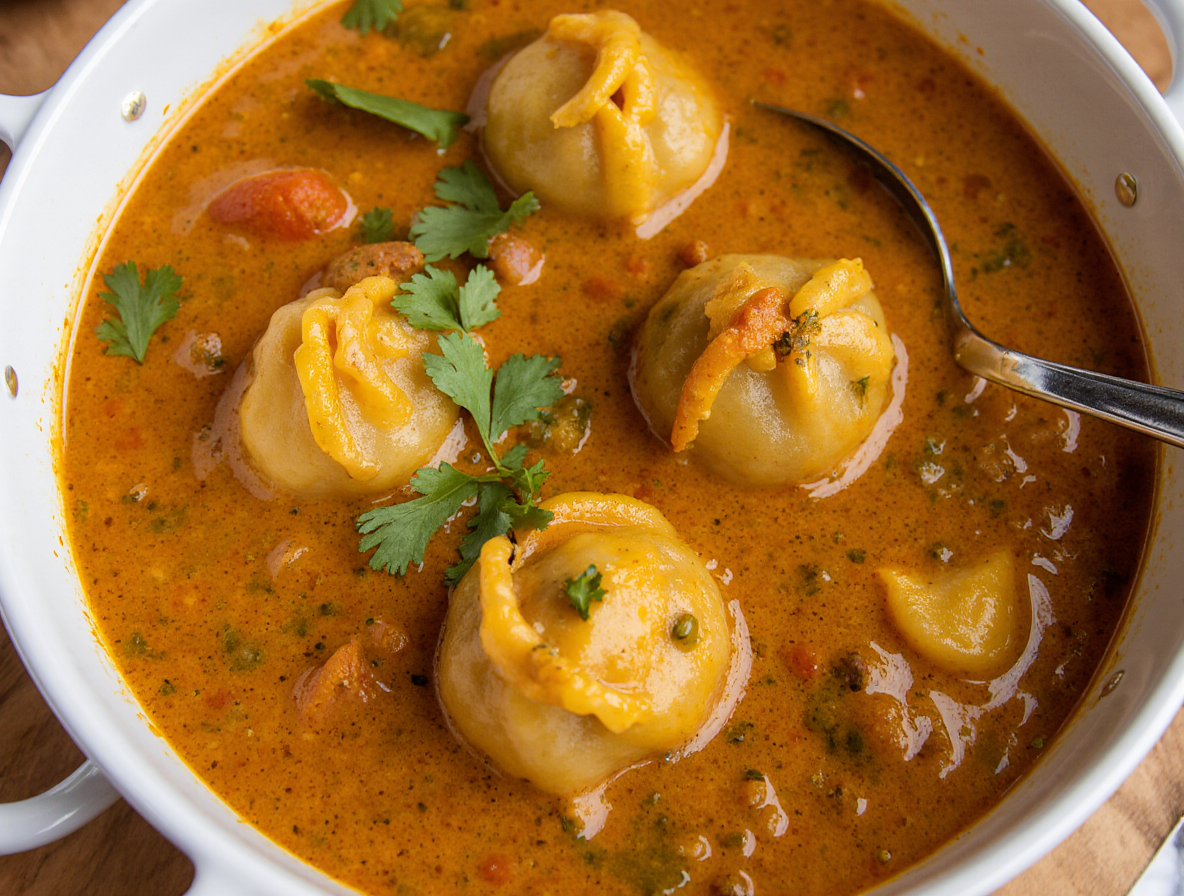How to Make Authentic Thai Dumpling Soup: A Chef’s Secret Recipe
Thai dumpling soup surprisingly takes less than 30 minutes to prepare, yet delivers the complex flavors you’d expect from authentic Thai cuisine. I’ve spent years perfecting this recipe, balancing the rich coconut curry broth with aromatic ingredients like ginger, lemongrass, and garlic that transport you straight to Thailand with each spoonful.
This spicy thai dumpling soup recipe is incredibly versatile. You can customize your curry dumpling soup with various dumpling types – chicken, veggie, shrimp, or beef – making it perfect for any preference. Furthermore, the thai dumpling curry soup can easily become vegan or gluten-free with simple substitutions. The balance of red curry paste with palm sugar creates that authentic sweet-heat combination that defines thai coconut curry dumpling soup.
We’ll walk through each step of creating this flavorful dish, from selecting the perfect ingredients to serving suggestions. You’ll learn chef-level techniques while keeping preparation straightforward and accessible. Above all, you’ll discover how combining fresh aromatics with quality curry paste creates a restaurant-worthy soup that’s destined to become a household favorite.
Choosing the Right Ingredients for Thai Dumpling Soup
The foundation of a memorable thai dumpling soup begins with selecting quality ingredients. The right components create that perfect balance of spicy, sweet, and savory flavors that makes this dish irresistible.
Red curry paste: types and flavor profiles
Red curry paste serves as the flavor backbone of authentic thai coconut curry dumpling soup. Essentially, this paste combines ground chilies, garlic, shallots, lemongrass, and galangal, creating a complex flavor base. Brands like Maesri and Thai Kitchen offer reliable store-bought options that deliver authentic taste without the work of making paste from scratch. For those seeking variety, Mae Ploy provides a richer, spicier profile ideal for spicy thai dumpling soup enthusiasts.
If you’re feeling adventurous, try doctoring store-bought red curry paste—add ground cumin, coriander seeds, and peanuts to create panang curry, or mix in cinnamon, cloves, and cardamom for massaman-style broth.
Coconut milk: full-fat vs light
When it comes to coconut milk, full-fat is undoubtedly superior for curry dumpling soup. Unlike light versions, which contain more water and less flavor, full-fat coconut milk (13-17% fat content) delivers richness and authentic taste. Always use canned, unsweetened varieties specifically meant for cooking—never substitute drinking coconut milk beverages, which lack the necessary fat content. Consequently, your soup would miss that silky texture that makes thai dumpling curry soup so satisfying.
Dumpling options: frozen, fresh, or homemade
Frozen dumplings work surprisingly well in this recipe. Options like gyoza, wontons, potstickers, or har gow all complement the rich broth perfectly. The filling matters less than quality—chicken, pork, shrimp, or vegetable dumplings all absorb the curry flavors beautifully. Indeed, many chefs prefer pan-frying dumplings before adding them to the soup for added texture contrast.
Essential aromatics: garlic, ginger, lemongrass
No thai dumpling soup recipe is complete without the holy trinity of aromatics:
- Garlic: Provides foundational depth
- Ginger: Adds zippy freshness and warmth
- Lemongrass: Contributes citrusy, floral notes
These ingredients should be sautéed first to release their essential oils and build the soup’s aromatic base.
Optional add-ins: mushrooms, bok choy, spinach
Adding vegetables transforms your thai dumpling soup from good to extraordinary. Baby spinach wilts beautifully into the broth, bok choy adds satisfying crunch, and mushrooms (particularly shiitakes) provide meaty texture and umami depth. Additionally, consider red bell peppers for sweetness, carrots for color, or even green cabbage for heartiness.
Step-by-Step Guide to Making Thai Dumpling Curry Soup
The magic of thai dumpling curry soup happens in five simple steps. Each phase builds essential flavors that transform simple ingredients into a vibrant, aromatic meal. Let me walk you through the process that makes this soup truly special.
1. Sauté aromatics to build the base
Begin by heating oil in a large pot over medium heat. Once hot, add finely chopped onions and sauté until they begin to soften, about 5 minutes. Next, add minced garlic, grated ginger, and lemongrass (if using). These aromatics form the foundation of your thai dumpling soup, creating layers of flavor that will permeate every spoonful. Allow them to cook just until fragrant—approximately 30 seconds to 1 minute—being careful not to burn the garlic.
2. Add curry paste and toast for depth
Subsequently, add your red curry paste directly to the pot with the aromatics. This crucial step requires patience—stir continuously and “toast” the paste for 2-3 minutes until it becomes intensely aromatic. During this process, the heat activates the essential oils in the spices, significantly deepening the flavor profile of your curry dumpling soup. The paste should darken slightly and smell incredibly fragrant.
3. Pour in broth and coconut milk
Gradually pour in chicken or vegetable broth while stirring to integrate the curry paste completely. Afterward, add the coconut milk, stirring continuously to create a smooth, unified broth. A good ratio is approximately one cup of coconut milk per tablespoon of curry paste. Let this mixture come to a gentle simmer—never a rolling boil, as this could cause the coconut milk to separate.
4. Simmer and season the soup
Once simmering, season your thai dumpling curry soup with fish sauce for saltiness, a touch of brown sugar for sweetness, and fresh lime juice for brightness. Allow these flavors to meld by simmering uncovered for about 5-10 minutes. Taste and adjust seasonings as needed—the broth should have a balanced flavor with no single element overpowering the others.
5. Add dumplings and cook through
Finally, carefully drop your chosen dumplings into the simmering broth. For frozen dumplings, they’ll need about 5-7 minutes to cook through completely. Fresh dumplings require less time, typically 2-3 minutes. The dumplings will plump up and float when done. For spicy thai dumpling soup, add a sprinkle of red pepper flakes or sliced Thai chilies just before serving.
Customizing Your Spicy Thai Dumpling Soup
The beauty of Thai cuisine lies in its adaptability, allowing you to personalize your thai dumpling soup to match your exact preferences. Even the most authentic recipes welcome creative adjustments.
Adjusting spice levels
Start with 1-2 tablespoons of red curry paste for a mild soup, or increase to 3-4 tablespoons for a spicier kick. If you’ve already made your spicy thai dumpling soup too hot, there are several remedies:
- Add coconut milk or yogurt to mellow the heat
- Incorporate a teaspoon of sugar or honey to balance spiciness
- Squeeze fresh lime juice to cut through the heat
- Serve with plain rice to neutralize the spice
Making it vegan or gluten-free
Creating a vegan version is straightforward—substitute vegetable broth for chicken stock and use plant-based dumplings or tofu. For those avoiding fish sauce, try soy sauce or tamari instead. Moreover, adding coconut cream creates extra richness while maintaining vegan status.
For gluten-free thai dumpling curry soup, use gluten-free soy sauce and dumplings. Most grocery stores now carry these alternatives, making adaptations simple.
Adding protein: tofu, chicken, or shrimp
Beyond dumplings, additional protein enhances your curry dumpling soup. Firm tofu adds texture while absorbing the broth’s flavors. Alternatively, sauté ground chicken with the curry paste or add shrimp during the final minutes of cooking for a seafood variation.
Vegetable variations to try
Your thai coconut curry dumpling soup welcomes countless vegetables: spinach, baby kale, shredded carrots, bok choy, edamame, broccoli, sugar snap peas, shiitake mushrooms, or baby corn. These additions increase nutritional value without compromising flavor.
Pan-frying vs boiling dumplings
Each cooking method offers distinct benefits for your thai dumpling soup recipe. Boiling creates tender dumplings that absorb more broth flavor, ideal for thin-skinned varieties. In contrast, pan-frying develops a crispy golden bottom, creating textural contrast against the silky soup. For the best results, try heating your pan until smoking before adding oil, then arrange dumplings flat-side down until browned (1-2 minutes) before adding them to your soup.
Serving and Storing Thai Coconut Curry Dumpling Soup
The finishing touches and proper storage methods can elevate your thai dumpling soup from excellent to extraordinary. First and foremost, I’ve found that the right garnishes and sides create a complete dining experience worthy of any Thai restaurant.
Best toppings and garnishes
The perfect thai coconut curry dumpling soup deserves vibrant garnishes that enhance both flavor and appearance. Fresh herbs like cilantro, Thai basil, or thinly sliced green onions add brightness to each spoonful. For texture contrast, try:
- Crispy fried shallots or toasted coconut flakes
- A sprinkle of sesame seeds
- Drops of chili oil or crisp for heat lovers
- Finely sliced kaffir lime leaves for aromatic punch
A squeeze of fresh lime just before eating is absolutely essential—its acidity balances the richness and brings harmony to the dish.
What to serve on the side
Alongside your curry dumpling soup, jasmine rice makes the perfect companion. In Thailand, diners traditionally take some rice in their spoon before adding soup, allowing the flavors to intermingle. Other excellent pairings include:
Thai cucumber salad for refreshing crunch Spring rolls or crispy tofu for textural contrast Simple flatbread for dipping into the rich broth
How to store leftovers
For thai dumpling soup recipe leftovers, proper storage is crucial. Place cooled soup in airtight containers and refrigerate for up to 3-4 days. For longer preservation, freeze the broth (without dumplings) for up to 3 months.
When storing spicy thai dumpling soup, keep the dumplings and broth separate whenever possible to prevent the dumplings from becoming soggy.
Reheating tips to keep dumplings intact
To maintain the integrity of dumplings in your thai dumpling curry soup, gentle reheating is key. For stovetop reheating, warm the broth over medium-low heat until simmering. Then, either add the stored dumplings or fresh frozen ones just before serving.
Alternatively, when preparing ahead, I recommend adding dumplings only to portions you’ll consume immediately. For future servings, cook fresh dumplings in the reheated broth to maintain their perfect texture.
Conclusion
Thai dumpling soup undoubtedly stands as one of the most rewarding dishes you can create at home. Throughout this guide, we’ve explored how simple ingredients transform into a rich, aromatic meal that rivals any restaurant offering. Certainly, the magic lies in balancing quality ingredients – from the right curry paste to full-fat coconut milk and fresh aromatics that build layers of flavor.
After making this soup countless times, I’ve found that personalization makes all the difference. Whether adjusting spice levels, switching proteins, or accommodating dietary needs, this versatile recipe adapts to your preferences while maintaining its authentic character. Furthermore, those little extras – crispy garnishes, fresh herbs, and that essential squeeze of lime – elevate the soup from delicious to extraordinary.
Remember that patience during crucial steps pays dividends, especially when toasting the curry paste or allowing the broth to simmer and develop depth. Meanwhile, proper storage techniques ensure you can enjoy leftovers without sacrificing quality, though adding fresh dumplings to reheated broth yields the best results.
Above all, this Thai dumpling soup represents everything wonderful about home cooking – accessibility paired with impressive results. Therefore, gather your ingredients, trust the process, and prepare to create a bowl of comfort that transports you straight to Thailand. Your family and friends will surely request this flavorful soup again and again.
FAQs
Q1. What are the key ingredients for an authentic Thai dumpling soup? The key ingredients include red curry paste, full-fat coconut milk, dumplings (frozen or fresh), and aromatics like garlic, ginger, and lemongrass. Fish sauce, brown sugar, and lime juice are used for seasoning, while vegetables like mushrooms or bok choy can be added for extra flavor and nutrition.
Q2. How can I adjust the spice level of my Thai dumpling soup? You can control the spiciness by adjusting the amount of red curry paste. Start with 1-2 tablespoons for a mild soup, or increase to 3-4 tablespoons for more heat. If the soup becomes too spicy, you can add coconut milk, a touch of sugar, or lime juice to balance the heat.
Q3. Can I make Thai dumpling soup vegan or gluten-free? Yes, you can easily adapt the recipe. For a vegan version, use vegetable broth, plant-based dumplings or tofu, and substitute soy sauce for fish sauce. To make it gluten-free, use gluten-free soy sauce and dumplings. Most of the other ingredients are naturally gluten-free.
Q4. What’s the best way to cook dumplings for Thai dumpling soup? You can either boil the dumplings directly in the soup or pan-fry them before adding. Boiling creates tender dumplings that absorb more broth flavor, while pan-frying gives a crispy texture that contrasts nicely with the silky soup. Cook time varies depending on whether the dumplings are fresh or frozen.
Q5. How should I store and reheat leftover Thai dumpling soup? Store the soup in airtight containers in the refrigerator for up to 3-4 days. For best results, keep the dumplings separate from the broth to prevent sogginess. When reheating, warm the broth gently on the stove and add fresh dumplings just before serving to maintain their texture.


